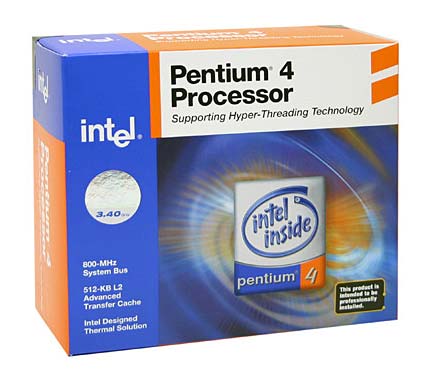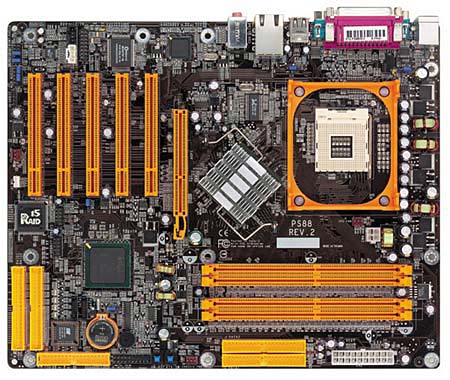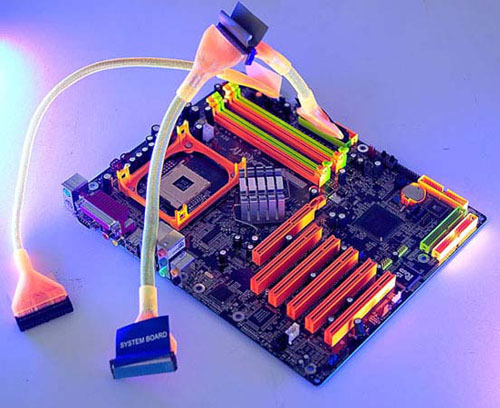Buyer's Guide: High End System - May 2004
by Wesley Fink on May 26, 2004 11:00 AM EST- Posted in
- Guides
CPU and Motherboard Alternatives
CPU: Intel Pentium 4 3.4C (512K L2 cache) NorthwoodMotherboard: DFI (875P chipset)
Price: CPU - $416 shipped (retail heatsink and fan). Motherboard - $174 shipped

Despite the fact that cost is a secondary concern in recommendations for a High End system, it is still difficult to recommend the $1100 3.4GHz Pentium4 EE when the 3.4GHz P4C (Northwood) is 60% less with the same core and 512KB cache instead of 2.5MB. 250% seems a hefty premium for the extra cache when the impact on performance is fairly small. If you want the bragging rights that come with the top Intel CPU, then get the P4EE, but the 3.4C is our recommendation at about the same price as the AMD Athlon 64 3400+. Both offer similar performance in today's applications depending on exactly which applications you use. For Desktop Applications, the 3.4C and 3400+ are virtually equal. If you do a lot of encoding, then the pendulum tilts toward the 3.4C over the 3400+ for now. If you're a gamer, the Athlon 64 3400+ is a better performer in most games. If 64-bit capabilities matter to you, then the AMD Athlon 64 is your only option. We suggest that you research which processor fits you best. A good place to start is at AnandTech's latest CPU article.
One advantage of a Pentium 4 is Hyper Threading, which makes a single processor behave like two multiple processors in some ways. Hyper Threading can increase performance substantially in multi-tasking situations, but the impact is less noticeable as clock speed increases. In today's applications, HT does not offer much benefit, though this may change in some future applications.
Intel seemed to design their labeling system to utterly confuse the buyer, so it is worth some efforts to clear the misunderstandings. An Intel Pentium 4 labeled with a "C" after its core clock speed (3.4C, in this case) is based on the Northwood core, has 512K of L2 cache, and is built on (mostly) 0.13-micron technology. A Pentium 4 labeled with an "E" after its core clock speed (3.4E for example) is based on the Prescott core, has 1MB of L2 cache, and is built on (mostly) 0.09-micron technology. Finally, a Pentium 4 labeled with an "EE" after its core clock speed (3.4EE, for example) is based on the Northwood core, has 512K of L2 cache plus 2MB of L3 cache, and is built on (mostly) 0.13-micron technology. The C, E, and EE Pentium 4 processors all run at 800MHz FSB and are dual channel DDR capable. While the future for Intel is slated to be the Prescott CPU, the slower speed and heat make the Prescott a difficult choice over the Northwood at current speeds. Performance becomes less an issue as speed increases and the heat issue is also improving. Next month's Socket 775 CPU from Intel will be Prescott-based and we have already seen that Prescott optimizations in the chipset can provide a big boost on Prescott Performance. The point here is this: Intel is constantly refining the Prescott, as they did with the original Pentium 4, so Prescott must be considered a work-in-progress that is getting better every day.
One of the most amazing turnarounds in the computer industry has been DFI. The large OEM partner decided to go after the enthusiast market with their own brand and transformed themselves from "Diamond Flower International" into "Designed For Innovation". It takes real performance to achieve this kind of transition and DFI has delivered this in spades in their LAN Party motherboard series.

The LAN Party 875B is an excellent and flexible home for a 3.4C, particularly in the latest Rev. B version. The Asus P4C800-E and DFI 875B LAN Party seems to make every recommended list as the top two motherboards for Intel enthusiasts because they are both solid performers at stock speeds and they both are capable of incredible performance with the fastest memory and Intel processors on the market. Our nod for top end system goes to the DFI because high end systems should stand out in some way, such as incredible performance or incredible looks. The DFI has both and you certainly will notice this motherboard as it is also unique to look at, particularly under black light. The 875B LAN Party also does the eye-candy trick without giving up anything in performance or flexibility.

While the price of the DFI is toward the high end, it includes matching glowing cables, a Front-X box for front ports, and a PC Transport to carry your PC. All these features would cost quite a bit extra if you had to buy them on the side, so there is definitely value in the DFI 875B. If the extras don't matter much to you, the same basic board is available as the DFI 875P Infinity for about $40 less. Revision B of the DFI has a greater range of adjustments than the original LAN Party and it also sports CMOS reloaded, a unique feature allowing several custom BIOS setups to be saved and selected in CMOS. All the top-end features are here with the notable exception of Firewire, so if you require Firewire, choose another board or add a Firewire PCI card. In addition to all the high-end goodies in the LAN Party box, there is an impressive feature list that includes Intel SATA RAID, Intel Gigabit CSA LAN, High Point 4-device IDE RAID supporting RAID 0, 1, 0+1, and 1.5 (a method to stripe and mirror using just 2 drives), 6-channel audio featuring the CMedia CMI9739A chip and a SPDIF IO bracket, and 8 USB 2.0 ports. End users who own the 875 LAN Party tell us that it is bullet-proof and one of the most stable motherboards they have ever owned - always a great recommendation for a high end motherboard.
Listed below is part of our RealTime pricing engine, which lists the lowest prices available on the Intel CPUs and motherboards from many different reputable vendors:
If you cannot find the lowest prices on the products that we've recommended on this page, it's because we don't list some of them in our RealTime pricing engine. Until we do, we suggest that you do an independent search online at the various vendors' web sites. Just pick and choose where you want to buy your products by looking for a vendor located under the "Vendor" heading.










59 Comments
View All Comments
Pumpkinierre - Wednesday, May 26, 2004 - link
At first, I was shocked at your choice of FX53 as a cpu because this is the last of the Sckt940 FX and upgradeability to later FXs would not be possible. Upgrade ability is not one of your criteria but it certainly is mine as I expect an expensive mobo to span two generations of cpus, video cards and even memory. But really Skt940 is more trustworthy (and possibly cheaper) than even 939 as other posts point out because it is the server cpu-opteron. So the mobo might handle the dual core opterons next year. After this revelation I thought the FX51 might cut a few dollars but your price list has it $20 MORE than its bigger brother! AMD go figure?!The FX is still a rip-off and the new Skt 939 3800+ looks like its got a lot of grunt, according to the french article below, but runs hot (104Watts, 50-60C) and this is 130nm- Prescott anyone?:
http://www.x86-secret.com/popups/articleswindow.ph...
They only found 0-5% increase with dual channel for same speed cpu and it had problems with four dimms- dropped to 2T timing or to DDR333 with DS modules. And the price may be expensive with AMDs habit of selective release from the high end like previous a64s:
http://www.overclockers.com/tips00588/
With the Skt478 P4 you're limited as an upgrade to P4EEs coming down in price unless 3.6 N'wood or Prescott skt478 appears (which is hardly worth while anyway)- neither of which is likely.
So the Sckt940 is not a bad option. If only those FXs would drop into the $500 range.
SHO235V8 - Wednesday, May 26, 2004 - link
I agree that there seems to be a huge spread, but I also assume it will be adjusted in the next mid level guide. I too have been waiting for the 939 boards, but I may not wait much longer considering VagrantZero's points regarding new M/B technologies and DDR2 which will be commonplace by the time I upgrade in a year or two. Besides, there are sometimes issues with the first release version of new technologies. Anyone else know of a better reason to hold off for the new boards? Will dual channel memory be that much faster?Dismal - Wednesday, May 26, 2004 - link
I was a little scared at first that the non-FX Athlon 64's would be completely forgotten about when opening the guide. But I was glad to see some mentioning in there. Hopefully they will still stay in the guides. I want good performance but I just can't spend the kind of cash to buy an FX. Recommendations in the mid-range guide don't seem to fit the kind of performance I'm looking for either. (I agree with rdclark's post above about the gap between mid-range and high-end). I don't think I'm savvy enough to go with overclocking. The price of the Athlon 64 3400+ seemed to be a good match for me. Hopefully they'll still remain in the guides.JKing76 - Wednesday, May 26, 2004 - link
Aluminum cases don't dissipate heat any faster than steel.Locutus4657 - Wednesday, May 26, 2004 - link
Well I have to say, you did finally remove one of my biggest bet peives with these guides. I never could understand why Evan kept recommending 120GB drives for a high end system, Personally I'm considering getting 160GB for my system, and right now I just have an entry level computer ( AXP 2200+ ). One can never have enough hard drive space!GokieKS - Wednesday, May 26, 2004 - link
Great choices, and it's nice to finally have a truly good case being recommend. But since there's still such a big part of the $5K budget remaining, why not something even more high-end, like the SilverStone SST-TJ03 Nimiz? ;)The 193P is an excellent monitor, no doubt, but as one of the 19" LCDs limited by a 1280x1024 resolution, the extra $150 or $200 of the Viewsonic VP201 is definitely worth it. And if you have two of them... ^^
Other than that, just about everything seems fine, even if I personally would go for the A64 3200/3400 instead of the FX53, and pair it up with a nForce3 250Gb mobo.
~KS
Da3dalus - Wednesday, May 26, 2004 - link
Seems like good choices. The only thing I'd choose differently would be the case and the alternative 200GB HD, I'd choose the S-ATA version of that instead of the IDE version. The price difference is really tiny and S-ATA is just plain nicer (I hate those big IDE cables).rdclark - Wednesday, May 26, 2004 - link
I'd like to see some performance benchmarking of these systems, especially as this high-end guide's system costs a cool thousand more than the previous high-end guide's. How much of a difference is there, or are you just buying expensive bragging rights?The new guide also leaves a fairly large gap between the mid-range and the high-end system; the mid-range is still suggesting an XP2800+, while this jumps right to the highest of the high-end. That removes a valuable basis for comparision (and decision-making) in the Athlon 64 3xxx space, which (IMO) seriously lowers the value of these guides.
cosmotic - Wednesday, May 26, 2004 - link
Why not reccomend the DDW-082 instead of the DDW-081?VagrantZero - Wednesday, May 26, 2004 - link
I wouldn't rec you getting 2gb of ram. There's nothing [aka games] out there that uses it, not even D3 or HL2. I doubt 2gigs will really become a good thing until U3 [2006] and by then DDR2 should be coming into its own making your DDR obsolete. I'd say save $300 and get a 3400+/3700+. From x86's article [foreign website, here's the translated url http://translate.google.com/translate?u=http%3A%2F...] the 754 3400+ was outperforming the 939 3500+ in the majority of benchs. I'll wait and see how the 3700 handles the 3800, but if it wins I'm sticking with the old socket [I'd have to upgrade my mobo eventually anyways thanks to PCI-E, SATA300, and DDR2 so 939 isn't anymore future proof for me than 754]. Plus there was talk of 104W power requirments [THAT'S MORE THAN THE PRESCOTT!] and that the new socket chips ran almost as hot as intel offerings. It's just one article so take it with a grain of salt, but I have my suspicions.Also, if you don't plan to OC Corsair XMSPC3500s would be a great pick.